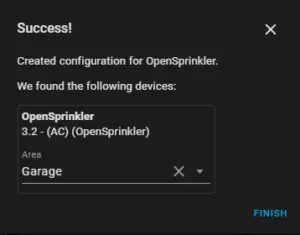

If you have ground (GND) or rain sensors (I don’t), then plug those into OpenSprinkler as well. Do this one last, as you probably don’t want to provide power to OpenSprinkler until everything is setup correctly. The power cable will be inserted into the orange block it doesn’t matter which side they go into. The black power cable has a red and a black wire. The white COM wire goes into the COM port. Once you have your OpenSprinkler setup, you will assign your P/MV to the “Master” section. Plug this into an available zone (either 7 or 8). The black P/MV cable is your pump/master valve. The red zone cables should be inserted into the corresponding zones (Zone 1 on the old system goes into #1 on OpenSprinkler). Insert each wire and tighten them down with a small screwdriver. Just in case you didn’t know, the orange and green wiring blocks can be removed to insert the cables in easier. Then, you will insert those cables into the corresponding ports on the OpenSprinkler unit. Your setup might not have a P/MV wire, but if it does – you’ll need to plug that into an available Zone port on OpenSprinkler. In short, the only cables you really need to unplug from the old system into the new are: I’ve never opened up my sprinkler before, so this was all brand new for me. However, one thing that was lacking was how to physically install the various cables and zones into the unit. If you ever move houses and plan on keeping your OpenSprinkler, then you can quickly plug the wires back in correctly to the old system. I recommend taking the time to label every cable and takes pictures. I purchased both the OpenSprinkler unit and 24VAC adapter from here: Įverything you need to know about installing OpenSprinkler can be found in the getting started guide. If you’d like to go the DIY route, you can follow one of their github guides to install it on a raspberry pi. If you purchase the pre-assembled kit, nothing else is needed and no soldering is required. Total cost was $172.95 for both after shipping. I just purchased the pre-assembled OpenSprinkler with a 24v AC adapter. I currently have a 6-zone Hunter Pro-C, so I didn’t need to purchase one.

Depending on how many sprinkler zones you have will determine whether you need to purchase a Zone Expander. In this guide, I will show you how to install OpenSprinkler into your existing sprinkler system in 2021.įirst, read over their getting started guide. If you’d like to play around with a live demo, you can do that here: OpenSprinkler is web-based sprinkler controller for your lawn, garden, or plants. After doing some research, I stumbled across an open source project called OpenSprinkler. You can control your device from outside the local network with proper port forwarding and use of the WAN IP within the application or by using a VPN.One of the most recent smarthome projects I’ve worked on was making my sprinkler system “smart”. This application requires you to own an OpenSprinkler that is properly connected to your network. *Multiple supported languages (Afrikaans, Chinese, Czech, Dutch, French, German, Hebrew, Hungarian, Italian, Mongolian, Norwegian, Polish, Portuguese, Slovak, Slovenian and Spanish) * View current weather and forecast status for the device location * View graphical and tabulated representation of log data * View visual representation of upcoming scheduled programs * Launch ad-hoc or defined programs instantly

OpenSprinkler is an open-source Internet web-based sprinkler timer / controller built upon the Arduino platform. The application allows you to automatically detect and control your OpenSprinkler irrigation system(s).


 0 kommentar(er)
0 kommentar(er)
